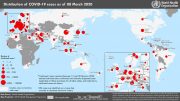
A global team of researchers proposing a new framework for enacting worldwide pledges to restore nature
This decade must be the turning point, where we transform humanity’s relationship with nature and put the planet on a path to recovery, argues a global team of researchers in a paper published on Friday, January 22, 2021, outlining a new framework for implementing global commitments to restoring nature, The Mitigation and Conservation Hierarchy — or, more snappily, Four Steps for the Earth.
The United Nations is currently developing a new post-2020 Global Biodiversity Framework, for the world to ‘live in harmony with nature’ by 2050. This will be negotiated in Kunming, China, later this year.
The researchers, from 22 institutions, led by the University of Oxford’s Interdisciplinary Centre for Conservation Science, argue there has never been a more important time for this bold vision, and everyone has a role to play in its delivery. The paper, published by One Earth, shows how to change our overall impact from negative to positive in four distinct steps, the ‘4Rs’:
- The refrain step involves avoiding negative impacts on nature as far as possible.
- The reduce step involves minimizing damage to nature where it cannot be completely avoided.
- The restore step involves remediating any immediate damage to nature.
- The renew step involves investing in revitalizing nature.
Lead author, Professor E.J. Milner-Gulland, says, ‘This paper represents a real team effort, with authors from academia, business and government. We’re excited to launch this idea and hope that it will be useful to many different groups as they work to realize the vision of the post-2020 Global Biodiversity Framework. It’s a huge challenge, with many different facets, and we hope that Four Steps for the Earth will provide an intuitive and flexible framework for tying all the threads together.’
“Conservation actions need to move beyond a niche interest of ‘conservationists’, to be incorporated in to the everyday actions and decisions of governments, businesses and individuals.”
What makes the Mitigation and Conservation Hierarchy unique is that it enables all types of negative and positive impacts on nature, carried out by different groups at different scales, to be accounted for within the same framework. It is focused on identifying actions that contribute towards an aspirational goal, such as leaving nature in a better state than we found it in.
However, the paper maintains, ambitious goals are only meaningful if they can be translated into concrete actions across all sectors of society. Most human activity involves natural resources. As such, conservation actions need to move beyond a niche interest of ‘conservationists’, to be incorporated into the everyday actions and decisions of governments, businesses, and individuals.
Last year, the International Union for Conservation of Nature’s partner organizations voted to support this framework and to push for it to be widely used. The authors hope it will help countries to plan and monitor the actions that they need to commit to in order to ‘bend the curve of biodiversity loss’, as economies recover post-COVID-19.
Project coordinator at Oxford, Henry Grub, adds, ‘This framework will, hopefully, present a turning point in the way institutions such as Oxford think about their biodiversity impact. Our impacts cannot be overlooked because of the positive research we do – rather we hope the ‘4Rs’ will transform efforts to tackle the environmental impacts of the food we eat in canteens, the paper we put in printers, the land we build on, and much more.’
Reference: “Four steps for the Earth: mainstreaming the post-2020 global biodiversity framework” by E.J. Milner-Gulland, Prue Addison, William N.S. Arlidge, Julia Baker, Hollie Booth, Thomas Brooks, Joseph W. Bull, Michael J. Burgass, Jon Ekstrom, Sophus O.S.E. zu Ermgassen, L. Vincent Fleming, Henry M.J. Grub, Amrei von Hase, Michael Hoffmann, Jonathan Hutton, Diego Juffe-Bignoli, Kerry ten Kate, Joseph Kiesecker, Noëlle F. Kümpel, Martine Maron, Helen S. Newing, Katrina Ole-Moiyoi, Cheli Sinclair, Sam Sinclair, Malcolm Starkey, Simon N. Stuart, Cath Tayleur and James E.M. Watson, 22 January 2021, One Earth.
DOI: 10.1016/j.oneear.2020.12.011









Where does the Scientific Method come into this? I’d consider this article to be more philosophy, politics, and religion than science!
The word “holistic” appears in the title, but not in the article. That almost stopped me from reading the article. In the past, I have noticed that whenever the word “holistic” is used, it implies a supposedly better way of thinking which, in detail, doesn’t include thinking at all.